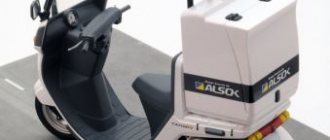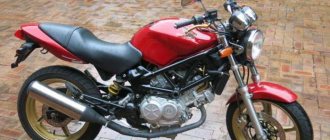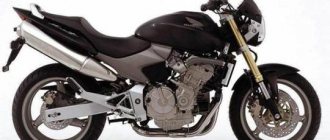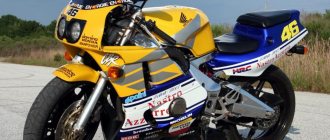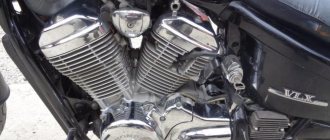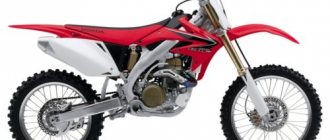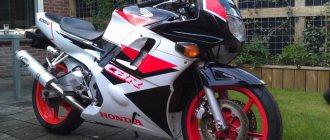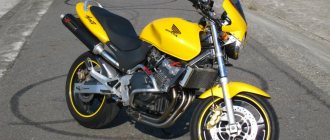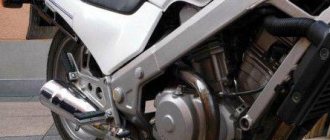Bike features
Here are the main features of the Honda VFR 750 F:
- four-cylinder engine;
- stylish design typical of the class;
- ease of landing.
The last point is especially worth noting, because for the owner of a sports touring motorcycle, it is very important how comfortable it is to spend hours traveling on it. The Honda VFR 750 F is excellent in this regard, and riding it, either alone or with a passenger, is a pleasure.
Content
- 1 Engine
- 2 Chassis
- 3 Suspension
- 4 4.1 Models 1986–1987 - VFR750FG/H (RC24)
- 4.2 1986–1987 - VFR700F / VFR700F2 (RC26)
- 4.3 1986–1987 — VFR750RK (RC24)
- 4.4 1988–1989 - VFR750FJ/K (RC24)
- 4.5 1990–1993 - VFR750FL/M/N/P (RC36)
- 4.6 1994–1997 - VFR750FR/S/T/V (RC36-2)
- 4.7 Japanese market versions only
Dimensions and weight
This motorcycle reaches 2180 mm in length, 700 mm in width, and 1185 mm in height. The wheelbase here is 1470 mm, while the seat height is 805 mm. The weight of the motorcycle including fuel is 224 kg. The gas tank volume is 21 liters, which is quite enough considering the gasoline consumption of 6.7 liters per hundred kilometers. Of course, the latter indicator will largely depend on your driving style.
Honda VFR750F Interceptor 1986-1997
Honda VFR750F Interceptor The motorcycle world was rocked when Soichiro Honda introduced the CB750, an in-line four-cylinder engine, in 1969. But by 1980, the concept had already received the initials UJM - Universal Japanese Motorcycle. But Mr. Honda's fertile mind was generating new ideas, and he felt that the V-4 engine would be ideal for sports motorcycles. With a blank sheet of paper, a few million yen, and complete secrecy at his disposal... he launched a new project. Sometimes even a company with such a renowned reputation as Honda can screw up, which is exactly what it did with its new, high-performance V-4. The Honda VF750F Interceptor sportbike was introduced in late 1982 and the motorcycle world was once again buzzing with excitement... but when the beast was put to the test, things went wrong with the upper camshafts and their bearings, which were clearly inadequately lubricated. Of course, Honda fixed this problem, at considerable expense and a blow to the company's reputation. Sales have declined. Honda engineers had to start redesigning the Interceptor. They wanted to create a V-4 that would win back the respect of customers... no matter how much it cost. By 1986, the VF had become the VFR, and the only thing the two models had in common was the cylinder bore and piston pitch (70 x 46.8 mm). Everything else was completely different. The most noticeable thing was the appearance. While the VF looked like a track racing bike, the VFR seemed more street oriented, despite sporting a full fairing. Honda decided to make a road bike like the factory RVF because the money came from selling general purpose motorcycles rather than from outrageously expensive race bikes. The road bike had some racing modifications, such as changing the cam drive from a chain drive to a gear drive, which cost four times as much. The cam chains on the VF stretched too easily, and the new transmission, which included eight gears in the middle of the engine, interfered with the fairing. An even more important change was to the crankshaft, which now used a 180-degree layout instead of the previously used 360-degree layout. This made it possible to change the cylinder head block, installing 36 mm carburetors instead of 34 mm. Much work has also been done to reduce the overall weight, resulting in the VFR engine weighing 10% less than the VF, and the maximum revs increased by 500, from 10,500 rpm to an astonishing 11,000 rpm. This, in turn, increased power - according to the press release, by 22 hp! But these were factory numbers related to power at the crankshaft and perhaps even at the piston dome. One magazine that tested both bikes reported actual power outputs of VF (77 hp) and VFR (82 hp). Stands usually don't lie. The chassis was the subject of admiration for the sports motorcyclist. The double-bar aluminum frame weighed just over 30 pounds (14 kg), and was flexible enough to satisfy both the street rider and long-distance enthusiast. The engineers got rid of everything they could, right down to the aluminum running boards, and as a result, the VFR weighed 44 pounds (20 kg) less than the VF. The wheelbase was also reduced by half an inch to 58.1″ (1476 mm). The VFR retained the 16-inch (406 mm) front wheel and 118-inch (457 mm) rear wheel found on the VF. The 37mm Showa fork had air adjustment and 27.5 degrees of head angle with 4.3″ (109mm) of trail. The Pro-Link shock was good, but definitely not the best, and only provided spring tension adjustment. The 5 gallon (19 L) fuel tank allowed a range of 170 miles (274 km) between fill-ups. The whole thing was quite expensive (compared to other 750s) at $5,500, and you had to add another $4K to that price if you wanted the racing kit, which included some very fancy titanium valves. But even in standard configuration, the motorcycle could cover a quarter mile (400 m) in less than 11 seconds. The VFR750F Interceptor did not appear in US showrooms for the next three years due to Harley's tariff on 700cc motorcycles, although the 699cc version remained on sale until late 1987. In 1988, the RC30, aka the VFR750R, appeared in Europe, although it was not imported to the United States until 1990. The following circumstance led to the appearance of the second version of the VFR750F, without the Interceptor name. Insurance companies fined motorcyclists who dared to own motorcycles with names like Interceptor and Hurricane, so Honda simply removed those names from the fairing. These new VFRs came with a revised chassis using a single-sided swing arm, a gesture of recognition to the French company ELF (Essence & Lubrifiants de France), which specializes in new frame designs. The front fork diameter was increased to 41mm, it used cartridges as dampers, the head angle was 26 degrees, and the trail was 3.9″ (99mm). And the wheels became 17-inch (432 mm). At the same time, the weight of the motorcycle increased by 30 pounds (14 kg). But remember that this was a road bike, not a racing bike. The buyers were happy. Sales were satisfactory. But clients always want something new or updated. By 1994, the VFR750F had been completely redesigned. Its appearance was reminiscent of the NR750, weight was reduced, power increased, and fuel tank capacity increased to 5.5 gallons (21 L). It was painted red with a black bottom and black wheels. This color scheme remained unchanged for the next three years. Prices became more attractive as the VFR sold for $8,200, while the similar Kawasaki ZX-7 and Suzuki GSX-R750 went for $8,100. If someone is serious about winning track races, the RC30 costs $15,000, double the VFR. And if you need parts that provide very serious speed, then you need to add another 10 thousand to this. But enough discussing 750 cm3. The VFR was intended for athletes, but it was good for the road, and for occasional long trips, but not for racing. So why was its engine displacement left at 750 cm3? For the 1998 model year, the engine's displacement was increased to 781 cc and it was named VFR800FI, where the "I" stood for fuel injection. And the Interceptor name has returned after being absent for so many years.
VFR750F Interceptor 1986 rear view
Chassis and brakes
Since this is a sports touring bike, it is not surprising that its frame is diagonal and aluminum. This gives it the lightness it needs when driving fast on a wide open road. The wheels are, of course, alloy, and the steering wheel has a class-specific shape.
The rear suspension is a progressive monoshock absorber. At the front there is a 41 mm telescopic fork. Braking at the rear is a 296mm disc with a two-piston caliper, while at the front there is a pair of discs of the same diameter as the rear, assisted by two-piston calipers.
Chassis
| This section may contain original research . |
The 1986 VFR750F used what Honda calls a diamond frame because the engine is set into the frame like a jewel in a piece of jewelry. This frame design is now called double spar. The 1986 VFR750F frame uses the engine as a stressed member, and the cast aluminum headstock is connected to the rear castings using 28 by 60 mm (1.1 by 2.4 in) extrusions.[ citation needed
] Downtubes are 30 by 40 mm (1.2 by 1.6 in).[
citation needed
] The VFR750F was the first in the 750 class with an aluminum double-spar frame,[
citation needed
] simply weighing[
peacock term
] 14 kg (31 lb) and the closest object on the road to the VFR,[
opinion
] The GSX-R also had an aluminum frame, but had a conventional twin-cradle design.[
citation needed
]
Recommendations
- Rapid Transit: 1986 Honda VFR750F Interceptor
, motorclassics.com - ^ a b c d
"Honda Sales Brochure". Honda. 1986. Retrieved February 7, 2019. - ^ a b c d f g gram hour i j
Cycle June 1986 [
page needed
] - ^ a b c d Honda V-Force: V4 Four-Stroke Engines on the Road and the Track
. Haynes Pub. ISBN 978-1859604212. - ^ a b
Backus, Richard (July–August 2006).
"Honda VF700S Saber touring bike." Classic motorcycles
. Retrieved 2019-09-20. […] The Honda VF700S Saber was a touring motorcycle that followed the V45 Saber. It represents an interesting chapter in motorcycle history because it belongs to a group of Japanese motorcycles called "tariff busters." - ^ a b
Lemmy (03/05/2018).
"Motorcycle Tariffs and Harley-Davidson: Lessons from the Past." Regular protector
. Revzilla. Retrieved 2019-09-20. What's more, many Japanese motorcycles have been redesigned to squeak just under 700cc. Cm; such bicycles are still informally called “tariff offenders.” - ^ a b
"VFR750RK Installation Guide". Retrieved February 7, 2019. - ^ a b
bennets.co.uk: Honda VFR: a history lesson, April 4, 2014, retrieved August 7, 2021. - https://bikeswiki.com/Honda_VFR750F#Specifications
, retrieved August 7, 2021.- ^ a b c
Smith, Robert (July–August 2015). "Rapid Transit: 1986 Honda VFR750F Interceptor." Classic motorcycles. Retrieved August 18, 2021. - ^ a b c d f
"Review of HONDA VFR750 (1995-1998)". Motorcycle News. November 24, 2006. Retrieved August 18, 2021. - "The Transatlantic Challenge of 1986". YouTube
. Retrieved January 8, 2021. - "Race Results - Isle of Man TT Official Website." Iomtt.com. 2021. Retrieved 2011-12-27.
- "VSB ~ 1986 Honda VFR750." vintagesuperbike.com. Retrieved 2011-12-27.
- "Brian O'Shea: AMA Superbike Collector - Mr. Superbike, Part II - Motorcyclist Magazine." Motorcyclist. Retrieved 2011-12-27.
Brief history of the model
- December 1982 - start of production and sales of the model.
Model
: Honda VF750F (Japan).
Factory designation:
VF750FC.
- 1983 - model available in North America and Great Britain.
Model
: Honda VF750F (V45 Interceptor - USA) (Japan, North America, UK).
Frame number:
JH2RC150DM~ (USA).
Factory designation:
VF750FD.
- 1984 is the final year of production.
Model
: Honda VF750F (V45 Interceptor - USA) (North America, UK).
Frame number:
JH2RC150EM~ (USA).
Factory designation:
VF750FE.
